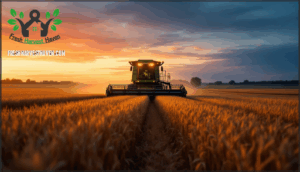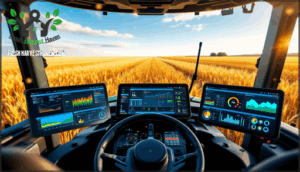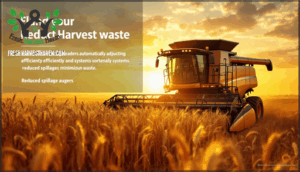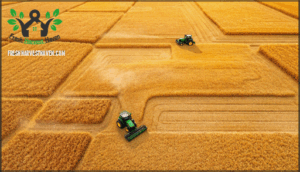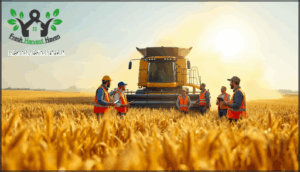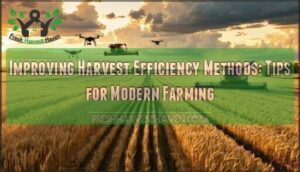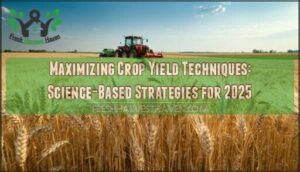This site is supported by our readers. We may earn a commission, at no cost to you, if you purchase through links.
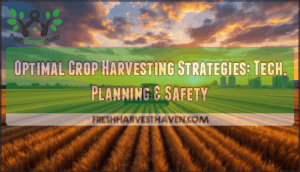 A single missed harvest day can cost a farm thousands of dollars—yet most operations still rely on weather guesswork and outdated schedules that leave money in the field. The gap between traditional harvesting and what precision agriculture makes possible isn’t just a matter of convenience; it’s the difference between capturing peak crop value and watching yields deteriorate while equipment sits idle.
A single missed harvest day can cost a farm thousands of dollars—yet most operations still rely on weather guesswork and outdated schedules that leave money in the field. The gap between traditional harvesting and what precision agriculture makes possible isn’t just a matter of convenience; it’s the difference between capturing peak crop value and watching yields deteriorate while equipment sits idle.
Modern ideal crop harvesting strategies combine real-time data, GPS precision, and strategic timing to cut field time by 40% while improving quality. The shift from reactive to predictive harvesting transforms how farms coordinate labor, maintain soil health, and navigate the narrow window between crop maturity and market opportunity.
Table Of Contents
Key Takeaways
- Multi-row harvesting equipment combined with GPS-guided systems cuts field time by up to 40% while reducing fuel consumption by 10-15%, which translates to roughly $40 per acre recaptured through just 2% reduction in grain losses.
- Real-time yield monitoring and machine learning algorithms now predict optimal harvest windows by analyzing weather patterns, crop maturity, and field conditions—transforming reactive scheduling into proactive decision-making that captures peak crop value before deterioration.
- Strategic harvest planning through staggered maturity dates and consolidated operations prevents labor bottlenecks and equipment downtime, with farms treating harvest as coordinated systems consistently pulling 15-20% more revenue from the same acreage.
- Soil health foundations—particularly precision calcium application and conservation tillage that reduces erosion by 90%—directly enable better yields, while inadequate soil management undermines even the most advanced harvesting technology.
Maximizing Harvest Efficiency With Modern Techniques
Modern harvesting isn’t about working harder—it’s about working smarter. The right techniques can slash your time in the field while boosting what you pull from it.
Here’s how today’s most efficient operations are getting it done.
Multi-row and Consolidated Harvesting Methods
When you’re racing against weather windows and labor costs, switching from single-row to multi-row harvesting equipment can slash your time in the field by up to 40%. Consolidated machines that cut and sort in one pass let you do the work of three operations with a single crew.
These harvesting techniques deliver substantial labour savings and workflow optimization, though you’ll need to weigh equipment costs against reduced compaction and lower crop damage. Automation benefits extend beyond labor reduction—you’re minimizing field passes, which protects soil structure and cuts fuel expenses.
GPS-Guided and Auto-Steer Equipment
Precision steering and GPS guidance let you overlap rows less, cover ground faster, and run equipment after dark without guesswork. GPS-guided combines and auto-steer tractors cut fuel consumption by 10–15% through reduced overlap while lowering operator fatigue during long harvest days. These precision agriculture technologies integrate seamlessly with data systems, creating digital field maps that inform next season’s planting decisions.
GPS guidance and auto-steer systems cut fuel use by 10–15% while reducing operator fatigue and creating field maps that shape next season’s decisions
Key benefits include:
- Reduced overlap minimizes wasted inputs and compaction
- Fuel efficiency gains from optimized field coverage patterns
- Data integration connects harvest operations to broader farm management platforms
Real-Time Yield Monitoring and Data Analysis
Yield monitors track grain flow and moisture as you harvest, creating field maps that reveal where you’re hitting targets and where you’re losing money. IoT integration feeds this data into cloud dashboards, while AI analytics flag stress patterns you’d otherwise miss until next season.
The global yield monitor market reached $3.3 billion in 2025, with accuracy improvements up 35% since precision agriculture took root. These systems are expected to see significant market growth through 2035.
VRA systems use this intelligence to adjust inputs field-zone by field-zone, turning raw numbers into yield optimization decisions that protect your margins—though regional barriers like rural connectivity and upfront costs still slow adoption for many operations.
Reducing Harvest Waste With Innovative Machinery
After you’ve mapped every profitable corner and drain with real-time data, the next step is making sure you don’t throw money away by leaving it on the ground or dumping it in the grain cart. Modern harvesting technology cuts losses through:
- Precision harvesting headers that adjust height and speed automatically
- Automated sorting systems that separate grain from chaff more efficiently
- Reduced spillage augers and conveyors with sensor-driven controls
- Careful treatment mechanisms that minimize kernel damage and crop bruising
These efficient harvesting techniques can reduce waste recycling needs while protecting harvest efficiency margins.
Strategic Planning for Optimal Crop Harvest
You can’t harvest crops on a hunch and hope for the best. Strategic planning means thinking ahead about when each crop will be ready, what the weather might do, and how to keep your crew from drowning in work all at once.
Let’s look at three ways to plan smarter and avoid the chaos that can sink your harvest season.
Scheduling Harvests by Crop Maturity and Weather
You can’t outguess Mother Nature, but you can work with her. Strategic harvest planning hinges on matching crop maturity stages with weather conditions using data forecasting tools.
These systems analyze historical patterns and current weather impacts to pinpoint best harvest timing. When you schedule based on maturity stage and forecasted conditions, you capture peak quality and yields.
Harvest scheduling tools let you sync operations with favorable windows, preventing weather-related losses and maximizing returns on every acre. Predictive models can estimate optimum harvest dates in advance.
Staggered Harvests to Manage Labor Demand
When you line up harvest dates so crops mature in waves rather than all at once, you dodge the labor crunch that can sink even a well-run operation. Planned harvest schedules with maturity date alignment reduce labor peak demand and prevent resource bottleneck avoidance.
Farm employees aren’t stretched thin, equipment stays productive, and efficient operations become the norm. Harvest planning turns labour shortages from a crisis into a manageable challenge through smart labour management in agriculture.
Preventing Bottlenecks in Harvest Workflow
Bottlenecks hit hardest when grain carts sit idle waiting for trucks, combines stall for lack of storage space, or crews scramble because one piece of equipment failed and threw the whole system off balance. Labor coordination and route optimization prevent these slowdowns, while equipment maintenance catches problems before they cascade.
Communication during harvest, paired with storage availability planning and weather contingency protocols, keeps your workflow moving and maintains harvest efficiency even when conditions shift.
Leveraging Technology and Data-Driven Practices
Technology has shifted farming from guesswork to precision, and you’ll see the biggest gains when you combine the right tools with smart data use.
Machine learning, real-time monitoring, remote systems, and integrated analytics now work together to sharpen your harvest decisions.
Here’s how each piece fits into a more efficient operation.
Machine Learning for Predicting Harvest Windows
Machine learning algorithms analyze historical data, weather forecasts, and real-time crop conditions to predict ideal harvesting windows with increasing accuracy. You gain precise timing recommendations that boost yield and quality while reducing waste.
Data-driven farming depends on three key elements:
- Algorithm selection suited to your specific crops and regional conditions
- Data requirements including soil sensors, satellite imagery, and yield records
- Real-time adjustments based on shifting weather patterns and field observations
Farmer adoption grows as model accuracy improves and systems integrate seamlessly with existing equipment.
Digital Tools for Monitoring Crop Health
Digital tools now give you a window into crop health that was impossible even five years ago, tracking everything from nutrient deficiencies to disease pressure before symptoms become visible to the naked eye. Remote sensing and drone imagery capture plant stress patterns across entire fields, while IoT sensors measure soil moisture and temperature in real time.
Farm management software integrates this data with predictive analytics, allowing you to address problems before they reduce yields.
Remote-Controlled Grain Handling Systems
You can now control grain dryers and monitor bin conditions from your phone, eliminating the need to station someone at the facility during unloading operations. Remote automation and sensor technology deliver these benefits:
- System integration links scales on grain carts directly to your farm management software
- Predictive maintenance alerts prevent costly equipment failures during peak harvest
- Data security protocols protect your operational information while enabling cloud-based control
This agricultural technology transforms grain processing from a labor-intensive process into a smooth, monitored operation you manage remotely.
Integrating Data Analytics for Decision Making
Raw harvest data becomes actionable intelligence when you connect yield monitors, weather stations, and soil sensors through a unified analytics platform. Farm management software integrates GIS mapping with predictive analytics, helping you make informed decisions about when and where to harvest.
Real-time optimization through data-driven insights transforms data-driven farming from reactive to proactive, giving you precision harvesting capabilities that boost returns. You utilize data and analytics to spot patterns others miss.
Enhancing Soil Health for Better Yields
Your soil isn’t just ground to plant in—it’s the foundation of everything you’ll harvest. Before you can improve timing or deploy the latest tech, you need to understand what’s happening beneath the surface.
Here’s how to build soil health that translates directly into better yields.
Tailored Fertilizer and Soil Amendment Programs
When you calibrate your fertilizer and amendment applications to match your soil’s specific nutrient profile, you’re basically giving each field exactly what it needs—nothing more, nothing less. Regular soil testing reveals nutrient deficiency correction opportunities and guides your sustainable fertilization strategy. Organic amendments complement synthetic options, while maintaining soil pH balance makes certain nutrients remain bioavailable. This targeted approach to nutrient management strengthens soil health and soil fertility without waste.
Five Principles of Effective Soil Amendment Programs:
- Conduct baseline soil testing every 2-3 years to track nutrient levels, pH balance, and organic matter content for informed decisions
- Select bioavailable calcium sources and other amendments based on your soil’s specific deficiencies rather than generic recommendations
- Apply fertilizer and soil amendment products at best rates determined by test results to avoid over-application and environmental runoff
- Integrate organic amendments with conventional fertilizers to build long-term soil fertility while meeting immediate crop demands
- Monitor crop response and adjust your nutrient management protocol annually based on yield data and visual field assessments
Importance of Calcium and Precision Application
Calcium mightn’t grab headlines like nitrogen or phosphorus, but your crops can’t build strong cell walls, move nutrients efficiently, or resist disease without it.
Liquid calcium products deliver better bioavailability compared to granular forms, letting you apply precise amounts exactly where soil testing shows deficiencies exist. This precision agriculture approach guarantees your pea growth and other crops access calcium when they need it most, strengthening plant structure and improving nutrient uptake throughout the season.
Sustainable Soil and Water Management Practices
Building on targeted nutrient applications, sustainable land management demands integrated approaches to preserve long-term productivity. Conservation tillage reduces soil erosion by up to 90%, while water conservation in agriculture through drip irrigation cuts applied water nearly in half without sacrificing yields.
Consider these sustainable farming practices:
- Crop rotation improves soil organic matter and cuts pesticide use by 33%
- Organic amendments like compost boost nutrient content 15-25% within three years
- Water recycling systems reduce total farm water withdrawals 20-40% annually
- Soil conservation techniques increase water infiltration rates 30-50%
These soil erosion mitigation strategies protect your investment while securing future harvests.
Safe Harvesting and Effective Team Communication
Harvesting isn’t just about getting crops out of the field—it’s about doing it safely while keeping your team in sync. Poor communication or untrained workers can lead to damaged equipment, injuries, and costly delays that eat into your bottom line.
Here’s what you need to focus on to run a smooth, safe harvest operation.
Training Workers in Safe Harvest Techniques
Proper training transforms inexperienced hands into efficient, safety-conscious harvesters who protect both themselves and your crop investment. Focus on injury prevention through thorough equipment safety protocols, hazard recognition drills, and clear emergency procedures. Address fatigue management early, ensuring workers understand rest requirements and productivity expectations.
| Training Component | Worker Safety Benefit |
|---|---|
| Protective gear protocols | Reduces injury risk during machinery operation |
| Safe harvesting methods | Minimizes crop damage and physical strain |
| Equipment safety checks | Prevents mechanical failures and accidents |
| Hazard recognition drills | Improves response time to dangerous situations |
| Emergency procedures review | Guarantees quick, coordinated crisis management |
Structured training and supervision programs deliver measurable benefits: fewer accidents, higher yields, and confident crews who execute best harvesting strategies consistently.
Efficient Communication Systems During Harvest
Clear, instant communication between combines, grain carts, and transport crews can mean the difference between a smooth harvest day and costly equipment idle time. Two-way radios in semis, combines, and tractors enable real-time equipment updates, while texting protocols keep neighbors informed about progress.
Daily briefings at the home farm establish your game plan, and solid emergency communication procedures help you navigate breakdowns without losing momentum.
Community Engagement and Labor Solutions
Facing labour shortages at peak harvest? Engage with the community—local labor pools often offer your solution. Part-time workers from community groups bring flexible support while strengthening collaborative farming networks.
- Recruit part-time workers through local churches, schools, and civic organizations
- Adopt collaborative harvesting techniques that share crews across neighboring farms
- Offer competitive wages that support local economies and build community goodwill
- Train community volunteers in safe practices before they enter fields
- Foster community involvement in farming through farm tours and educational events
Preventing Equipment Breakdowns and Ensuring Safety
Equipment failures during harvest don’t just cost you time—they can jeopardize your entire season’s profitability if you’re caught unprepared. Preventing equipment breakdowns starts with strict maintenance schedules and thorough operator training.
Establish clear safety protocols, conduct emergency preparedness drills, and make certain every worker understands safe harvesting techniques. Breakdown prevention through routine inspections and efficient use of farm equipment delivers measurable benefits—you’ll protect both your investment and your crew.
Frequently Asked Questions (FAQs)
How do weather patterns affect harvest timing decisions?
Weather conditions dictate harvest timing because rainfall impact delays field access, humidity levels affect grain moisture content, temperature effects influence crop maturity, frost risk threatens crop quality, and wind damage can cause yield losses during the harvest season.
What are optimal moisture levels for different crops?
You’ll want corn around 15-20% moisture, soybeans at 13%, and wheat between 12-14%. Grain crops harvested too wet risk spoilage during storage, while overly dry kernels shatter and reduce yields.
Use moisture meters before harvest timing decisions to protect crop quality and minimize drying process impact.
How can small farms adopt precision harvesting technology?
Small operations can start with affordable sensors and GPS-guided systems, then scale gradually. Shared equipment cooperatives reduce costs, while targeted training helps you interpret data effectively.
Precision agriculture doesn’t require a complete overhaul—strategic adoption of digital tools delivers measurable returns.
What insurance options protect against harvest-related losses?
You’ll want crop insurance types like yield protection policies and revenue protection plans to guard against losses. Hail damage coverage and preventative planting coverage address specific risks, while USDA RMA programs and disaster assistance provide additional financial security through thorough risk management.
How do crop rotation strategies influence harvest planning?
Crop rotation practices shift harvest schedules by staggering crop maturity dates across seasons. Strategic crop planning reduces pest and disease impact while improving soil health effects, which directly influences resource allocation shifts and the timing of harvest operations.
Conclusion
Operations that cut grain losses by just 2% through precision timing recapture roughly $40 per acre—enough to fund next season’s seed entirely. Your ideal crop harvesting strategies hinge on matching equipment capacity to field readiness, not calendar dates.
GPS systems eliminate overlap, yield monitors flag problem zones before they spread, and staggered schedules keep crews productive without burnout.
The farms that treat harvest as a coordinated system rather than a scramble consistently pull 15-20% more revenue from the same dirt. Timing still beats technology, but the right tools make timing possible.


